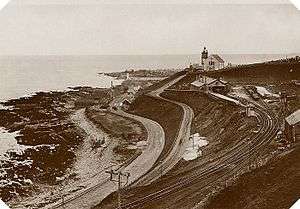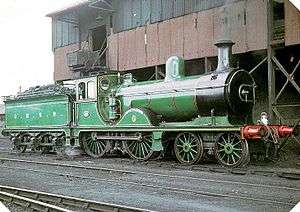Banff, Macduff and Turriff Junction Railway
The Banff, Macduff and Turriff Junction Railway connected the Aberdeenshire town of Turriff with the Great North of Scotland Railway's (GNSR) main line at Inveramsay. A separate company, the Banff, Macduff and Turriff Extension Railway, built extension to a station called Banff and Macduff. The junction railway, together with the junction station at Inveramsay, opened on 5 September 1857 and the extension opened on 4 June 1860.[1] Both railways were absorbed by the Great North of Scotland Railway on 1 August 1866,[2] and the line was extended 1⁄2 mile (0.8 km) to a new Macduff station in 1872.[3]
| Banff, Macduff and Turriff Junction | |||||||||||||||||||||||||||||||||||||||||||||||||||||||||||||||||||||||||||||||||
|---|---|---|---|---|---|---|---|---|---|---|---|---|---|---|---|---|---|---|---|---|---|---|---|---|---|---|---|---|---|---|---|---|---|---|---|---|---|---|---|---|---|---|---|---|---|---|---|---|---|---|---|---|---|---|---|---|---|---|---|---|---|---|---|---|---|---|---|---|---|---|---|---|---|---|---|---|---|---|---|---|---|
| Overview | |||||||||||||||||||||||||||||||||||||||||||||||||||||||||||||||||||||||||||||||||
| Locale | Scotland | ||||||||||||||||||||||||||||||||||||||||||||||||||||||||||||||||||||||||||||||||
| Operation | |||||||||||||||||||||||||||||||||||||||||||||||||||||||||||||||||||||||||||||||||
| Opened | 1857 | ||||||||||||||||||||||||||||||||||||||||||||||||||||||||||||||||||||||||||||||||
| Closed | 1966 | ||||||||||||||||||||||||||||||||||||||||||||||||||||||||||||||||||||||||||||||||
| Technical | |||||||||||||||||||||||||||||||||||||||||||||||||||||||||||||||||||||||||||||||||
| Track gauge | 4 ft 8 1⁄2 in (1,435 mm) | ||||||||||||||||||||||||||||||||||||||||||||||||||||||||||||||||||||||||||||||||
| |||||||||||||||||||||||||||||||||||||||||||||||||||||||||||||||||||||||||||||||||
Following the grouping in 1923, the line became part of London and North Eastern Railway and was nationalised, becoming part of British Railways. The Macduff branch closed to passengers on 1 October 1951, completely to the north of Turiff on 1 August 1961 and the remaining line on 3 January 1966.[4]


Introduction
This line was built to connect the coastal towns of Banff and Macduff with Aberdeen on the east coast of Scotland. It ran for 29 miles (47 km) across the open Aberdeenshire countryside. The railway was opened as far as Turriff in 1857, then on to Gellymill, just outside Macduff, in 1860. It was finally taken into the town of Macduff itself in 1872.[5] The Banff, Macduff and Turriff Railway Company was absorbed into the Great North of Scotland Railway network in 1866. Following the grouping in 1923, it became part of LNER. On nationalisation, in 1947, LNER itself was taken over by British Railways.
Construction
While the line was being built the company board walked the line to meet the local population to assure them that the coming of the railway would bring great benefits to them. There was such a hurry to open the line, the board even considered running trains before the ballast had been laid, but this did not happen. The station at Macduff was above the town and, such was the gradient, it was not possible to continue the line down to the harbour nor build a bridge across the River Deveron to reach Banff. In spite of the fact that Banff and Macduff are only separated by the river, to travel between the two towns by rail was a distance of 75 miles (120 km). In 1910 this it would have taken 31⁄4 hours.[6] A year following the opening of the line much of the fencing had rotted. A horse strayed onto the railway and a derailment occurred. The company were forced to renew the fencing at considerable cost.[5]
Running
The early locomotives to work the line were Class 1 2-4-0s designed by D.K.Clark and built by William Fairbairn & Sons of Manchester. These were fitted with Clark's patent smoke preventing system. They had a series of holes in the sides of the firebox above the fuel, that allowed jets of steam to be projected. The steam circulated air in the firebox. This better combustion is also reported to have resulted in improved fuel economy. Later Class F 4-4-0s were used. One of these employed was the LNER Class D40 Gordon Highlander currently in preservation owned by Glasgow Museum of Transport and on display at the Scottish Railway Preservation Society, Bo'ness. Coaches used were of the 4 and 6 wheeled variety. Various types of trucks were used by the freight trains.
Using
This line was never particularly busy. The first timetable showed three passenger trains and a freight train each way daily. This was soon reduced to three mixed trains. Traffic continued to go down. The line suffered competition from the Banff, Portsoy and Strathisla Railway. This route was quicker to the main Inverness to Aberdeen line.[6] Traders in Banff could not be expected to transport their goods across the bridge over the river, then up the hill to the station, when there was a more convenient station in Banff. The company's directors were particularly incensed with the Post Office. Instead of the mails been carried at a fixed rate they sent the postman up the line with the mailbags, while only purchasing a ticket like an ordinary passenger.[5]

Closure
By 1951 the line had become totally uneconomic and British Railways, who now owned the line, closed it to passengers. Freight traffic continued till 1966. While several item of rolling stock have been preserved some of which are in the museum of the Scottish Railway Preservation Society, many of them can be found on farms across the county.
References
- Vallance 1991, pp. 57–58.
- Vallance 1991, appendix 5.
- Vallance 1991, p. 59.
- Vallance 1991, Appendix 3.
- Thomas, chapter 10
- Thomas & Turnock, Page 178
Sources
- Thomas, John (1976) Forgotten Railways Scotland Chapter 10 pages 171 - 177 David & Charles ISBN 0-7153-7185-1
- Thomas, John & Turnock, David (1989) A Regional History of the Railways of Great Britain. Volume 15 North of Scotland Chapter 5 pages 157 & 168 David & Charles ISBN 0-946537-03-8
- Vallance, H. A. (27 June 1991). Great North of Scotland railway. The History of the Railways of the Scottish Highlands vol 3. David St John Thomas. ISBN 978-0-946537-60-0.CS1 maint: ref=harv (link)